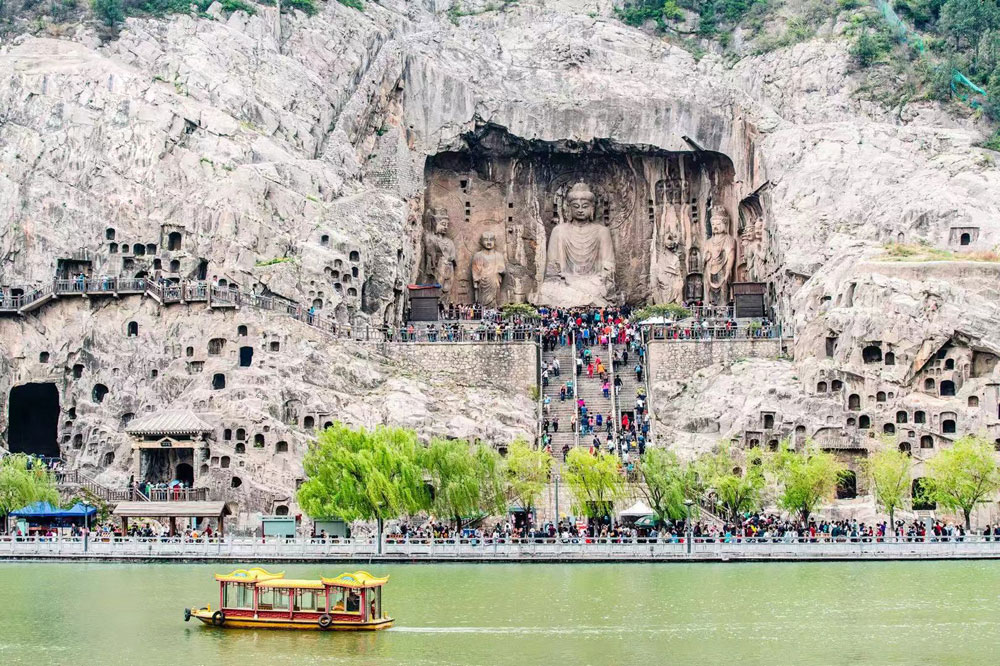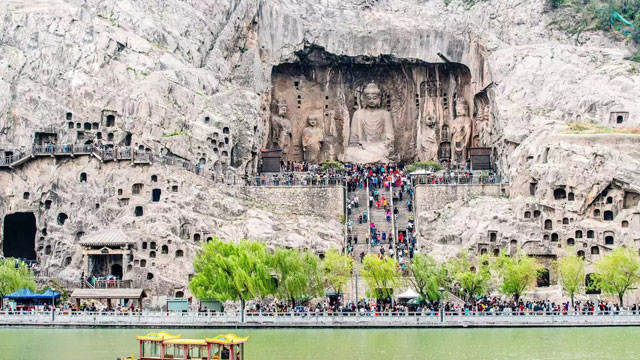Henan

Henan Province, referred to as "Henan", is the provincial administrative region of the people's Republic of China. Zhengzhou, the capital of the province, is located in the middle of China. Henan borders between 31 ° 23 '-36 ° 22' n, 110 ° 21 '-116 ° 39' e, Anhui, Shandong, Hebei and Shanxi in the north, Shaanxi in the West and Hubei in the south. The total area of Henan Province is 167000 square kilometers.
Henan Province is characterized by the potential of looking north to south, carrying on the East and opening the West. It is high in the West and low in the East, and consists of plain and basin, mountain, hill and water surface; it crosses four major water systems, namely, the sea river, the Yellow River, the Huaihe River and the Yangtze River. Henan Province is located in the warm temperate zone, and the south is trans subtropical, which is a continental monsoon climate which is transitional from north subtropical to warm temperate zone; Henan is located in the joint part of coastal open area and central and western region, and is the middle zone of China's economic development from east to West echelon.
As of may2019, Henan Province has 17 provinces, 1 directly under the jurisdiction of the province, 21 county-level cities, 85 counties and 53 municipal districts. Henan is known as "hinterland of Jiuzhou and thoroughfare of ten provinces", and it is an important comprehensive transportation hub and information flow center of human flow logistics in China.
In 2018, Henan Province achieved a regional GDP of 4805.586 billion yuan, an increase of 7.6% year-on-year, with an increase of 42.89 billion yuan in the first industry, an increase of 3.3% year-on-year; the added value of the second industry was 2203.483 billion yuan, an increase of 7.2% year-on-year; the added value of the tertiary industry was 217.365 billion yuan, an increase of 9.2% year-on-year.
Historical evolution
The origin of place names
Henan Province is known as Henan Province because most of it is located in the south of the Yellow River in history. In ancient times, the middle and lower reaches of the Yellow River were vertical and horizontal, forest was dense and wild. Henan was described as the place of human traction, which was the root of the pictograph "Yu", and also the origin of Henan abbreviated as "Yu".
History of construction
Henan is located in the middle and lower reaches of the Yellow River, and is one of the birthplaces of ancient Chinese civilization. At least 500000 years ago, human beings lived and propagated here. In the period of Peiligang culture, it produced handicraft industries such as agriculture, animal husbandry and pottery making more than 7000 years ago. By the middle and late period of Longshan culture more than 4000 years ago, the Central Plains entered the era of stone and copper ware and used them, and the emergence of private ownership and class sprouting.
During the Xia Dynasty, the Xia Dynasty was established in the Central Plains.
During the Shang Dynasty, they were successively settled in Bo, Xibo, Hulao, Xiang, Xing, Yan and Chaoge.
In the Western Zhou Dynasty, King Cheng of Zhou built the capital city of Zhou Luoyi.
In the Eastern Zhou Dynasty, the capital of Luoyang (Luoyang today).
During the spring and autumn and Warring States period, the capitals of song, Chen, Wei, Guan, Zheng, Xu, Yingguo, Cai, Wei and South Korea were in Henan.
Luoyang, the capital of liuxiuding, was in the Eastern Han Dynasty.
In the late Eastern Han Dynasty, Xuchang was moved to the capital.
Cao Wei, Cao Cao decided Luoyang, and moved Xuchang in the end.
In the Western Jin Dynasty, simayan was the capital of Luoyang.
After the unification of the Northern Wei Dynasty, the Emperor Xiaowen moved to Luoyang.
Later Zhao, ran Wei, Qianyan, Eastern Wei and Northern Qi all settled in Anyang.
In the Sui Dynasty, Luoyang was the east capital, and Henan, Yingyang, Chenliu and Liangxian were set up in Henan.
In Tang Dynasty, Luoyang was the eastern capital. During the period, Luoyang was moved to Luoyang for several times, and capital Gyeonggi and Henan Dao were set up in Henan Province.
In Wu Zhou Dynasty, Wu Zetian decided to change Luoyang to the capital of God.
The Five Dynasties of the Houliang, later Tang, later Jin, Han Dynasty, and later Zhou were all in Kaifeng, Luoyang.
The capital of the Northern Song Dynasty was Kaifeng, with Kaifeng government (today's Kaifeng) as Tokyo, Henan government (Luoyang today) as the Xijing, and yingtianfu (now Shangqiu) as Nanjing.
In the Southern Song Dynasty, the capital of Nanjing yingtianfu (now Shangqiu) inherited the throne of the Song Dynasty. In order to continue the imperial and legal system of the Song Dynasty, the name of the state was still Song Dynasty, which was known as the Southern Song Dynasty.
In the second year of Zhengyou of the Jin Dynasty (1214), the capital was opened and the Shangqiu was moved in the end. After the song and Jin Dynasties ruled the Huaihe River, the south of the Huaihe River in Henan Province belonged to the Southern Song Dynasty.
In Yuan Dynasty, Henan Province was set up in the north of the river, Kaifeng as the capital of Henan Province.
In Ming Dynasty, Henan Province had eight governments and one Zhili Prefecture.
In the Qing Dynasty, the division of Ming Dynasty was basically followed.
During the period of the Republic of China, Luoyang was the base of wupefu.
In 1926 (the 15th year of the Republic of China), fengyuxiang participated in the Northern Expedition war and settled in Henan.
In 1928 (the 17th year of the Republic of China), Zhang Guotao and Xu Qianqian opened up revolutionary bases in Dabie Mountain area, Henan and Anhui. Xinyang new county was the capital of the base area.
In May 1930 (nineteen years of the Republic of China), the capital of Henan Province moved from Kaifeng to Shangqiu. On October 6, the capital of Henan Province was relocated to Kaifeng City by Shangqiu City.
In 1932 (the 21st year of the Republic of China), after the incident of January 28, the Republic of China moved to Luoyang.
In 1939 (28 years of the Republic of China), proletarian revolutionaries such as pengxuefeng opened up the base area of Henan, Anhui and Soviet Union, and Yongcheng, Shangqiu, was the capital of the base area.
On January 10, 1949, the victory of the Huaihai Campaign ended and Henan Province was liberated.
In August 1949, the plain province was established in the north of the Yellow River, the capital of which was located in Xinxiang City, and Henan Province reserved the south of the Yellow River.
In November 1952, the plain province was abolished, and most of its administrative areas were incorporated into Henan Province.
In October 1954, the capital of Henan Province moved from Kaifeng to Zhengzhou.
In August 2019, with the approval of the State Council, it was agreed that Changyuan county should be abolished and county-level Changyuan city should be established in Henan Province.
administrative division
As of may2019, Henan has 17 provinces including Zhengzhou, Kaifeng, Luoyang, Pingdingshan, Anyang, Hebi, Xinxiang, Jiaozuo, Puyang, Xuchang, Luohe, Sanmenxia, Nanyang, Shangqiu, Xinyang, Zhoukou and Zhumadian, 1 province directly under the jurisdiction of Jiyuan City, 21 county-level cities, 84 counties, 53 municipal districts, 1791 towns and 660 Street offices. No. 22, Jinshui East Road, Jinshui District, Zhengzhou City, Sichuan Province.

Henan
-
1.Liaoning
Liaoning province is known as "ancient". Fengtian province "Shengjing", located Northeast China Abbreviation Liao Provincial capital Shenyang 。 Liaoning ranges from 38 degrees 43't
Time 2019-12-16 -
2.Jilin
Jilin Province, for short. Luck "Yes. The People's Republic of China Provincial Administrative Region, provincial capital Changchun 。 Located in China Northeast Central region, with Liaoning , In
Time 2019-12-16 -
3.Anhui
Anhui, abbreviated as "Anhui", is a provincial administrative region of the people's Republic of China. Hefei, the capital of the province. Located in East China, Anhui is bounded by 114 ° 5
Time 2019-12-16 -
4.Fujian
Fujian Province, referred to as "Fujian", is the provincial administrative region of the people's Republic of China. Fuzhou, the capital of Fujian Province, is located in the southeast coast
Time 2019-12-16 -
5.Henan
Henan Province, referred to as "Henan", the provincial administrative region of the people's Republic of China. Zhengzhou, the capital of Henan Province, is located in the central part of Ch
Time 2019-12-16 -
6.Hunan
Hunan Province, referred to as Hunan, is one of the 23 provinces in China, the capital of Changsha. It is bounded between 24 ° 38 ′ - 30 ° 08 ′ n, 108 ° 47 ′ - 114 ° 15 ′ e, Jiangxi in the East
Time 2019-12-16 -
7.Guangdong
Guangdong, referred to as "Guangdong", is the provincial administrative region of the people's Republic of China and the capital of Guangzhou. Because the ancient place name is widely believ
Time 2019-12-16 -
8.Guizhou
Guizhou, referred to as "Guizhou" or "Gui", is the provincial administrative region of the people's Republic of China. Guiyang, the provincial capital, is located in the hinterland
Time 2019-12-16 -
9.Yunnan
Yunnan Province, or Yunnan for short, is one of the 23 provinces in China. It is located in the southwest and the capital of Kunming. It is bounded between 21 ° 8 ′ - 29 ° 15 ′ N and 97 ° 31 ′ - 106 °
Time 2019-12-16 -
10.Shaanxi
Shaanxi, referred to as "Shaanxi" or "Qin", is the provincial administrative region of the people's Republic of China and the capital of Xi'an. It is located in the hinterland of C
Time 2019-12-16 -
11.Gansu
Gansu, referred to as "Gan" or "long", is a provincial administrative region of the people's Republic of China and the provincial capital Lanzhou city. It is located in Northwest China, connecting Shaanxi in the East, Xinjiang in the w
Time 2019-12-16 -
12.Xinjiang
Xinjiang Uygur Autonomous Region, referred to as "new", has its capital, Urumqi, located in Northwest China. It is one of China's five ethnic minority autonomous regions. With an area of 1664900 square kilometers, it is the largest provincial ad
Time 2019-12-16